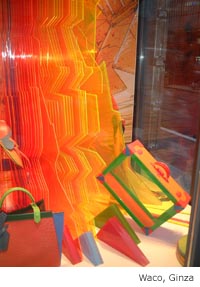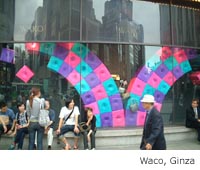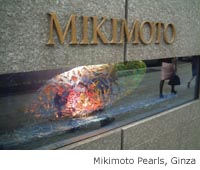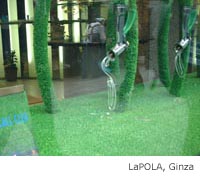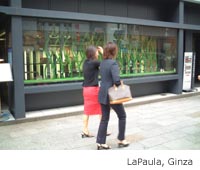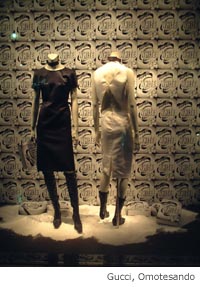Various locations around Tokyo
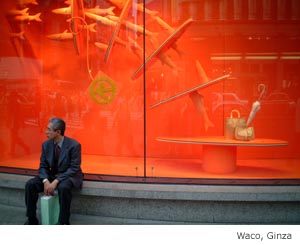
Fashion savvy, style conscious and brand crazy -- the Japanese
are the world's greatest shoppers. It should be no surprise then that
the feature display window in a shop is elevated to an artform. Reminiscent
of the 'tokonoma', a special place in Japanese houses for hanging scrolls
and displaying Ikebana, the feature display window is reserved for the
latest and most fashionable of desirables in the store. Be they pearls,
spectacles, shoes or electrical goods, a store window needs to be a thing
of beauty.
The most famous of Tokyo's shop windows is the Waco department store in
the commercial heart of Ginza. In spite of the surrounding huge TV screens
mounted on nearby buildings, blaring out pop beats and animations, the
Waco window always transfixes the passerby. Color floods from the glass
and reflects on the faces of those gazing in at the tableaux of shoes
and accessories. The window, which regularly changes, has often a whimsical
narrative theme to its display of bags shoes and accessories.
In the same area are the windows of Minimoto pearls and Shiseido cosmetics.
In keeping with the size of their product the pearls window is exquisitely
small. Like a medieval altars you need to approach it reverently to inspect
the details. Sometimes peacock feathers and sliver accessories enhance
the translucent pearl spheres. At other times, a stark minimal blackness
contrasts a fortunous mountain of gleaming beads.
The redesigned Shiseido building is designer-sleek from inside to out
Ð from basement to upper floors and has the coolest elevators to boot.
But the windows onto the street are a step above the rest of this modernist
Ritz.
Given over to artists and designers, the huge 4 meter windows have housed
dolls with silken hair dripping to the floor into large pools of water
and at other times complete dead trees including roots Ð spotlit and surreally-suspended
a meter above the floor. Recently they housed huge blue kimono with a
landscape of a cascading waterfall painted on their backs.
However, the zenith in creative windows on Chu Dori in Ginza belongs to
LaPola. Flower arrangements to faucets have filled this space but each
in an unexpected way. Unusual materials such as artificial grass and garden
hoses have on occasion been combined to create a furry green grid across
the glass.
Often secreted away among these design oddities are the beauty products,
the commercial core of it all, reduced to simply being financial patrons
for the art installation around them.
Not to be out-glitzed by Ginza are the very cool shops of Omotesando.
On either side of this high fashion boulevard are the Gucci headquarters
and the Anniversary (wedding) department store. They are in a perpetual
duel for stunning window displays.
In the past, this has included the incongruous ethnographically inspired
stack of African carvings and drums, together with wedding dress (Anniversary).
And the anthropomorphic stuffed zebra in designer boots (Gucci). It is
not just the big department stores that specialize in the art of display.
Almost every local area of Tokyo has a 'gofuku-ya', a shop that specializes
in Kimono and traditional wear. These stores have refined the art of fine
display. Letting the products doing the talking with flowing obis and
simply hung Kimono, they have maintained a grace and an eddy of elegance
in the cacophonous local shopping precinct.
But just as the store-windows have become art - so has art moved into
the window displays. In an attempt to bring art to the people the Tachikawa
Art Festival features art installations in department store windows. Recently
the Fuji bank has began a series of art windows in their Tokyo branch
offices. Inviting a range of people from recognized artists to school
groups to display their art in the bank windows.
Consumer display has long led the way for museums with lighting and display
techniques. A good Tokyo window can include costumes to rival Kabuki,
theatrics as passionate as No and the cool aesthetic of a Zen rock garden.
In Japan the objects of our desires are displayed with flair, encapsulating
a thousand years of visual and dramatic aesthetics.
